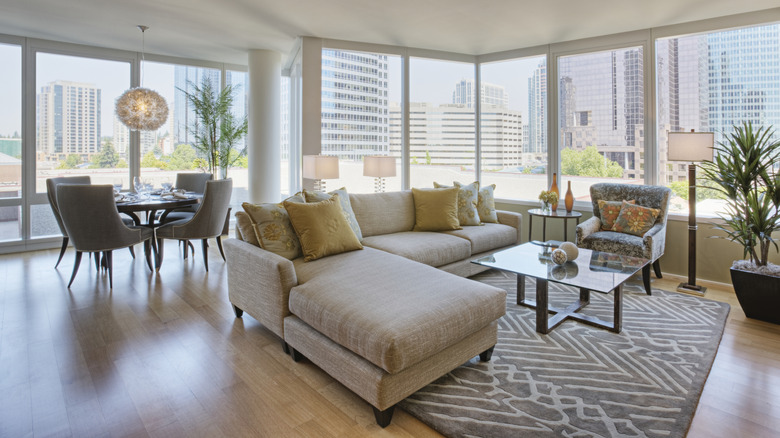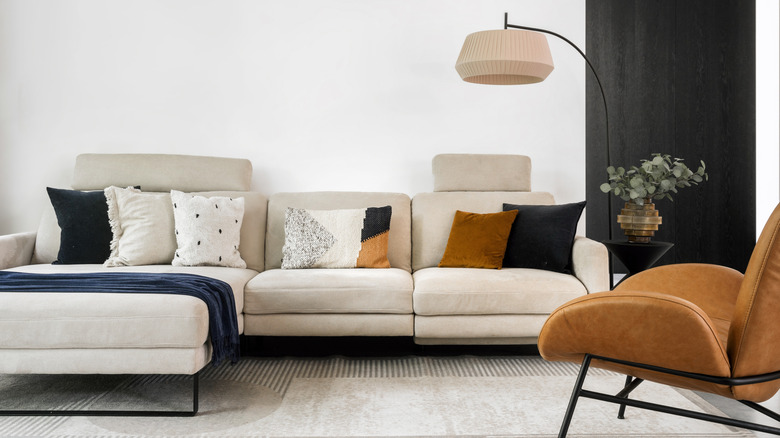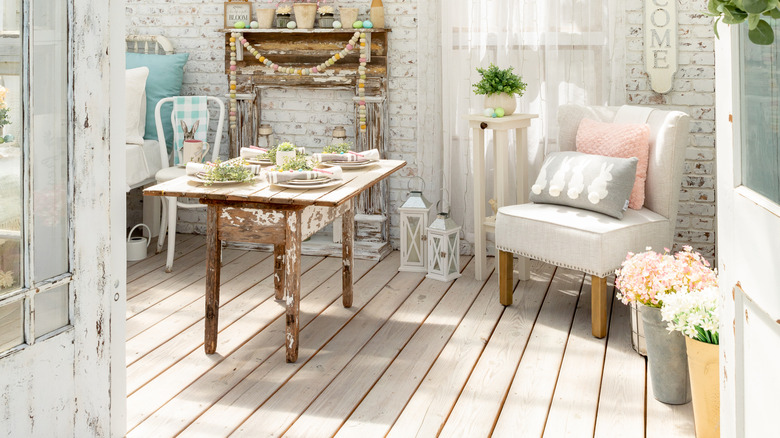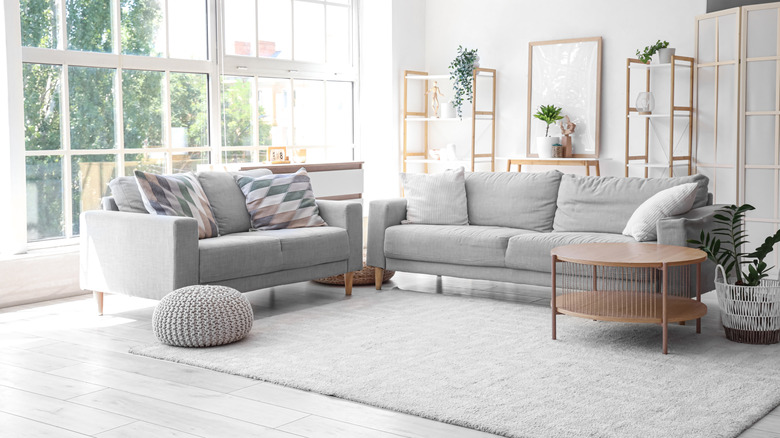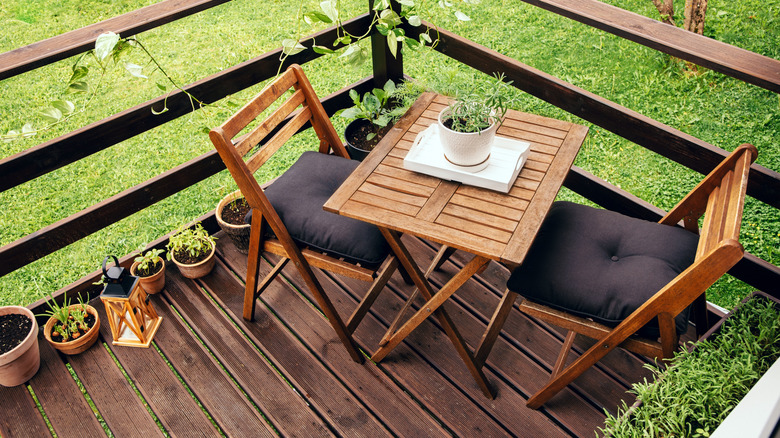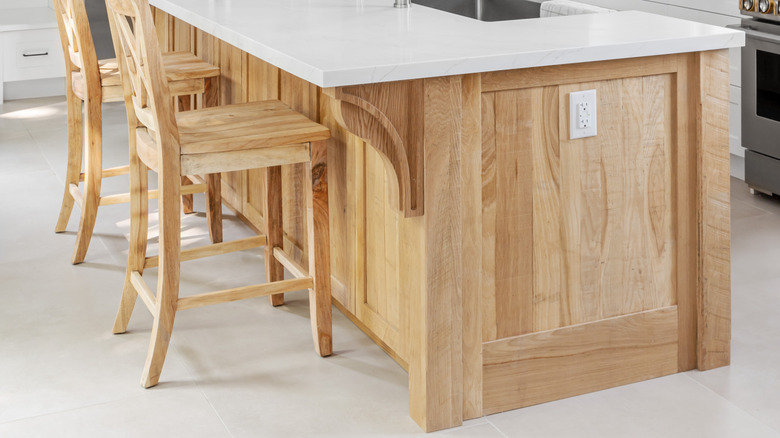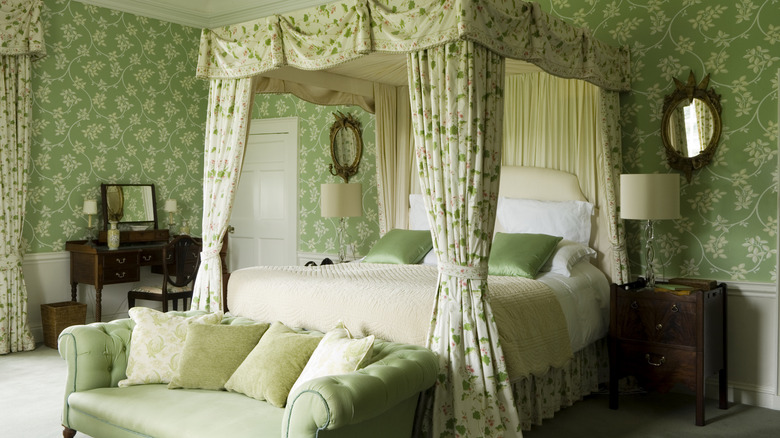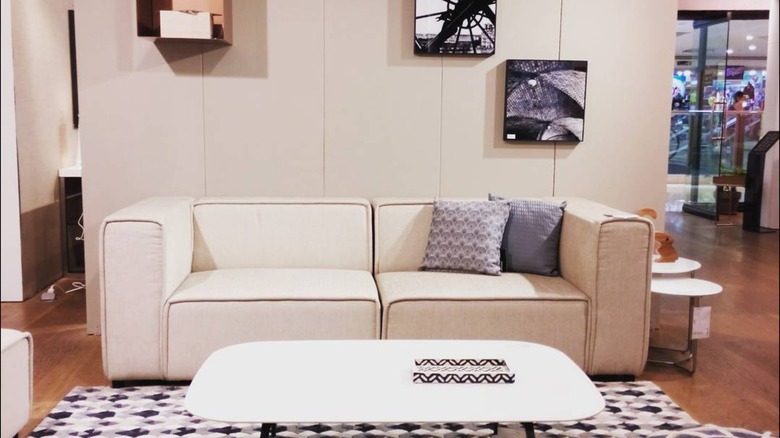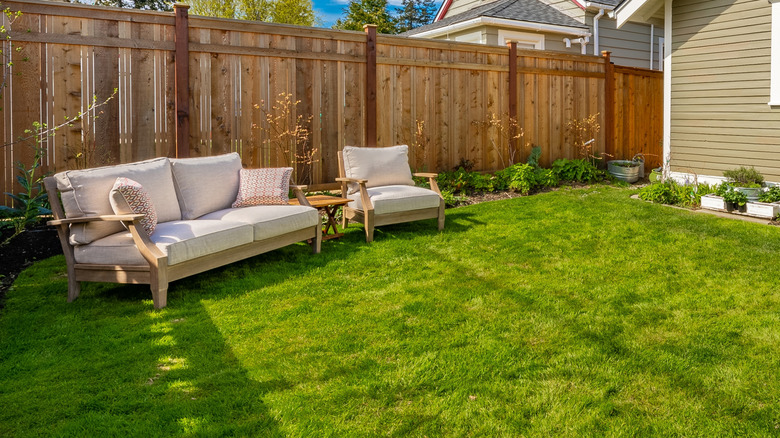Tired Furniture Trends That Are Now Becoming A Thing Of The Past
Are you still oohing and aahing over jumbo sectionals that will eat up over half of your room's square footage? Or, maybe you're still taken by the large "Eat, Pray, Love" signs overlooking all-gray furniture (with gray walls to match?). If yes, buckle up, because these furniture trends are losing popularity and the last thing you need is to spend your hard-earned money on a dated item. After all, furniture is substantial investment, and is expected to last several years. However, keeping up with the ever-changing trends and aligning them to your tastes can get overwhelming, unless watching HGTV is all you do (we listen and we don't judge).
So, to assist your search, House Digest reached out to seven interior designers for exclusive interviews to gather their insights on which furniture trends have fallen out of favor and what's taking their place. The gist? Bulk is out. So are matchy-matchy sets and all-gray profiles. In essence, any furniture trend that promoted staged sterility (which looked best in showrooms) at the behest of personality and character is a thing of the past. Additionally, fast, distressed, and boxy furniture that people have grown weary of over the years are being shown the door. With that said, let's explore the furniture trends you should avoid, as well as those you might consider investing in for your home.
Oversized sectionals are making space for their modular equivalents
In a way, millennials represent a generation raised on large, cushiony sectionals — an era where families gathered in the living room, cried watching Christmas movies while reclining in their seats with popcorn, and cuddled with their pets. So strong was the sense of comfort that the concept raged on through the 2000s, notwithstanding the economic doldrums. Since the seats were usually fixed, they defined the flow of the room, sometimes dominating the interior when people had to downsize. However, as Gen-Z — with their strong inclination toward renting and flexibility — takes charge, it appears oversized sectionals are finally passé. In his exclusive interview with House Digest, Chris Turner, owner and designer at Studio Nisho, admits, "We're starting to see furniture that's almost entirely meant for comfort take a backseat to some more modern and tailored options."
Basically, "Instead of bulky couches with fluffy cushions, we're seeing modular sectionals that don't quite take up the entire living room," he says. In case you missed the memo, modular sectionals have separate pieces that can be clubbed or detached as desired. This keeps things flexible when you need to upscale or trim down your furniture while relocating. It also allows for easy replacements of damaged pieces. Additionally, you get to experiment with different styling, such as L-shape, loveseats, U-shape, or pits, keeping things fresh and timeless — and most of all — in proportion with your room's size and zoning.
Distressed farmhouse furniture has lost its rustic charm, tipping the scales to a more modern look
Through her show "Fixer Upper" on HGTV, Joanna Gaines ushered in the modern farmhouse aesthetic (think exposed beams, shabby chic chandeliers, and flaky paint) into the collective lexicon. Distressed furniture, too, took on a new lease of life with homeowners deliberately aging their cabinets and dining tables, evoking the simplicity of farm life while adding charm, character, and warmth for good measure. However, Turner feels that, "The whitewashed, distressed look that is a big part of the farmhouse style decor is something that's overdone, and I think we'll see that trend slow down quite a bit."
When speaking to House Digest in an exclusive interview, Dani Gottschalk, interior designer at Tinzeltown, voiced similar sentiments about the farmhouse trend, specifically remarking on the sub-genre of coastal farmhouse. "If your furniture looks like it was washed up on the beach ... and leaves a splinter in your finger after a gentle stroke, call the furniture ambulance and get rid of it. ASAP. If it is not properly coated with paint, get some. If it has an uneven finish and looks like someone took a rock to it, replace it!" In short, distressed furniture is officially going out of style. But what should you replace it with? "Warmer and modern style furniture, at least within the farmhouse style," advises Turner. Match wood tones or organic fabrics with warm neutrals for a contemporary touch, or look for furniture with subtle patinas and cleaner lines.
All-gray furniture is falling out of favor with homeowners
Edging out beige and its tonal variants, gray took the interior design world by a storm in the 2010s, becoming the go-to for a neutral aesthetic. Gray floors, gray walls, gray furniture — everything gray had become the mainstay, with sterile, cool undertones being incredibly popular. But in his exclusive interview with House Digest, Artem Kropovinsky, founder and principal interior designer at Arsight Studio, clarifies that the all-gray routine has overstayed its welcome: "The trend of using exclusively gray colors is disappearing because people are bringing back personal style through colorful design choices. Gray continues to rule the neutral category yet it no longer controls how furniture looks."
With gray out, what colors are homeowners and designers gravitating to in 2025? "The design trend now opts for softer tones, which include brown, deep green, and soft pastels instead of current monochrome trends," explains Kropovinsky. And if the "color of the year" trends are any indication, he is pretty on point. For instance, one way to use Pantone's mocha mousse color in your home — as indicated by Pantone x Joybird collaboration — is in furnishings, like the couch or chairs. Another way to update your existing furnishings is to swap out cushions or seats for linen or woven fabrics in earthier colors like sienna or pinks. Essentially, homeowners are still looking for comfort by canvassing their furniture in earthier colors — just not from oversized couches.
With sustainability on the rise, fast furniture is losing its appeal
Minimalism had its moment in the early 2010s, and with it, so did Ikea. Since quality furniture sold for eye-watering prices, and Pinterest boards were inundated with clean, unimposing furniture, homeowners naturally gravitated to affordable fast furniture. But as economics go, cheap prices meant flimsy materials, and most of these items couldn't last even seven years (and they're quiet difficult to repair). The outcome? A throwaway culture that thrived on clogging landfills with gigantic mounds of mass-produced furniture, which isn't easily recycled, defeating sustainability goals. That's why Kropovinsky thinks fast furniture is a past trend and will hopefully remain there. "Fast furniture products lose popularity due to growing consumer interest in sustainable products made with skilled craftsmanship," he states.
So, how does one afford well-crafted products without blowing their budget? He elaborates, "Householders are choosing durable furniture items from sustainable brands, second-hand markets, or vintage stores." Simply refurbish or re-stain older items to fit your interiors. Or, even better, repurpose them! (Hint: Upcycling vintage trunks into coffee tables is all the rage currently). That said, Challie Stillman, vice president of creative at Resource Furniture, expands in an exclusive House Digest interview, saying, "Investing in high-quality pieces is always going to be the number one way to make a home look expensive, no matter the square footage, but the real key is quality pieces that work for your rooms." To make the right choice, follow these tips for ensuring you're buying furniture that's built to last.
White oak furniture isn't as hot as you would think
This might come as a shock (it definitely was for us), but apparently white oak isn't as cool as we thought — or at least isn't when it's the "lone" finish in the room. Not too long ago (checks notes, 2024 to be specific), white oak was the furniture industry's "It-girl," since she exuded warmth, sophistication, and resilience in busy areas. White oak was already considered a top-rated blonde hardwood flooring option and took off further when manufacturers realized its ability to tolerate warping could translate well into furniture. Naturally, homeowners ran with the concept, liberally utilizing white oak in their flooring, cabinetry, and furnishings.
But Teri Simone, head of design and marketing at Nieu Cabinet Doors, feels otherwise. In her exclusive interview with House Digest, she expands on her contrarian view, "I know this might be a hot take! But we are seeing people getting comfortable with wood tones that aren't all identical." Put simply, contrasting different wood finishes is in, with designers looking to "wood drench" the room (just like color drenching, but with wood). And the way to do it is by "bringing in some rich walnuts and MCM-inspired design and choosing one contrasting wood tone to pair with white oak flooring or cabinetry," Simone elaborates. Walnut or smoky-elm colors typically provide rich contrast, adding coziness to living rooms. Maple and cherry finishes are equally popular, as they complement the white oak as it ages into warmer undertones. Whichever finish you choose, though, stick to warmer undertones to avoid competition with the oak.
Matchy-matchy furniture sets aren't cutting it anymore
In the name of "cohesion," homeowners had taken recourse to matching their furnishings entirely. From beds and side tables to the cabinetry, everything had the same design. You would find a similarly-coordinated look in living and dining rooms. While doing so took the guesswork out of the equation, since you could buy matched sets directly from big box retailers, it rendered the room a predictable, flat look. But not for long. Matching furniture sets are going out of style, insists Bree Steele, product and design manager at RJ Living, in her exclusive interview with House Digest. "I see this as part of the same trend towards the cozy, relaxed interior space. Identical furniture sets are losing favor."
With personality and self-expression becoming key, homeowners are leaning toward curating varied pairings. Besides, how else could you inject your individuality into your home's interior without showcasing the pieces you picked up on your travels or from your local antique store? "Instead of every piece matching perfectly and the appearance of an over-engineered space, people are mixing materials, textures, and shapes to create a layered space that truly reflects their personality. Think timber and stone mixed with plush upholstery, rather than an all-coordinated look." Keep matching pieces (such as bedside tables) to a minimum, and don't be afraid to think outside the box. For a change, home improvement stores are all caught up on the matched set's demise, too, so expect diverse combinations when you hit them next.
Curves are in, boxy sofas are out
Once introduced as the perfect embellishment for contemporary designs, boxy sofas — in a fascinating turn of events — are now the very furniture that date your home. Their sleek lines, geometric shapes, and smidgeons of minimalism, while functional, leave a lot to desire in intimate spaces. With "the epidemic of loneliness and isolation" taking root (via the U.S. Surgeon General), people are craving conversations, and curved silhouettes enable that. They're called conversation or crescent pieces for a reason. "Boxy, ultra-structured sofas with sharp edges are out! Instead, people want soft, organic forms that prioritize comfort over stylish looks," explains Steele. Ginger Curtis, founder and CEO of Urbanology Designs, shared similar sentiments when she spoke exclusively to House Digest. She says, "Harsh, clinical minimalism is being replaced by softness — think rounded edges, textured fabrics, and cozy silhouettes."
Through their flowing lines, curved furniture add a softness to the room, allowing for a more organic layout. "The shift toward modular, curvaceous designs reflects a growing preference for flexibility and fluidity in living spaces," adds Steele. They also play into the resurgence of the art deco movement, another unexpected furniture trend that's coming back in style. Besides, "Softer shapes, sculptural furniture, and deeper seating invite warmth and comfort," clarifies Curtis. Luckily, curvy silhouettes aren't restricted to your couches, and instead include an expanding range of arched headboards, coffee tables, floor lamps, and more.
Bulky furniture in outdoor spaces is being replaced with something breezier
Echoing the switch in interior furniture designs, creators are looking to cut corners (literally) on outdoor furniture. "Again, as part of the same movement towards simplified and 'humanized' spaces, big and clunky outdoor furniture is leaving and being replaced with lighter, sculptural pieces with much slimmer profiles," says Steele. In a way, such compact options accommodate small backyard spaces where oversized furniture overwhelms. It may even inspire homeowners to turn their rooftop or balcony into sociable areas, since they are no longer trying to shoe-horn a hulking sectional where it doesn't fit! Being relatively lightweight, they yield greater functionality and convenience.
Moreover, outdoor furniture trends are flirting with the organic aesthetic that's lately become popular. "This trend [has] also translated in a move toward natural finishes and curved designs that speaks to a more effortless and organic approach to outdoor living, one that has character and adaptability," Steele adds. Watch for curly profiles in teak finishes that naturally melt into the outdoors, while adding a cozy touch. For more sustainable options, look for furniture made from FSC-certified (Forest Stewardship Council) wood. Also, keep things durable by investing in weather-resistant fabrics for cushions and lightweight, sleek wrought iron chairs — you don't want the natural elements to pour cold water on your hard work.
